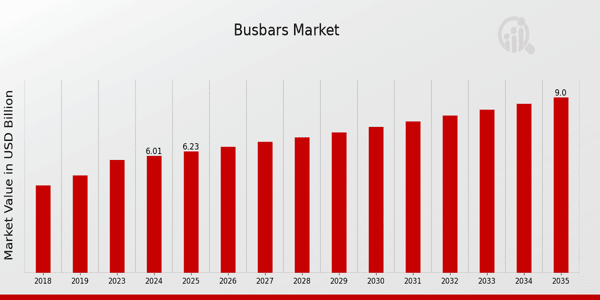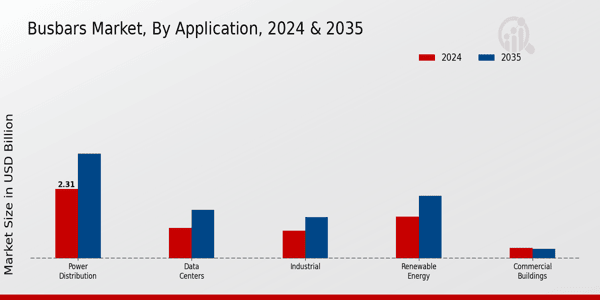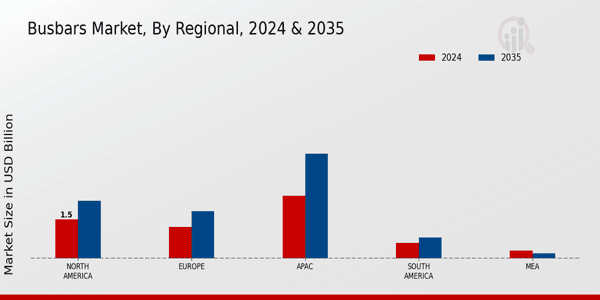Global Busbars Market Overview:
As per MRFR analysis, the Busbars Market Size was estimated at 5.79 (USD Billion) in 2023. The Busbars Market Industry is expected to grow from 6.01 (USD Billion) in 2024 to 9 (USD Billion) by 2035. The Busbars Market CAGR (growth rate) is expected to be around 3.74% during the forecast period (2025 - 2035).
Key Busbars Market Trends Highlighted
Various elements affecting the Busbars Market development are driving notable trends in it. Key market drivers include the rising need for energy-efficient solutions as businesses and governments work toward sustainable energy practices. As a result of this change, busbars in electrical distribution systems have been increasingly used, as they provide more efficiency than traditional wiring methods. The increase in renewable energy projects globally is also generating possibilities for creative busbar uses, especially in solar and wind energy industries, where they are crucial for controlling power distribution.
Busbars have been increasingly miniaturized and customized in recent years to fit the requirements of contemporary electrical systems. Technological developments and the demand for small solutions in sectors like telecommunications and data centres, which necessitate high-density power delivery, drive this trend. Furthermore, government rules pushing smart grid technologies and improved infrastructure are forcing market participants to concentrate on sophisticated busbar designs that fit naturally into these systems. Improving the safety and dependability of electrical systems is another significant development. Busbars are equipped with characteristics that will enhance their performance under different circumstances, hence helping to lower industrial operating downtime.
The busbar market is set to benefit from changing demands as businesses worldwide become more conscious of the requirement of consistent power delivery. Manufacturers have many chances in this situation to create new products and broaden their Busbars Market offerings.

Source: Primary Research, Secondary Research, MRFR Database and Analyst Review
Busbars Market Drivers
Growing Demand for Renewable Energy Sources
The Busbars Market Industry is poised to benefit from the increasing demand for renewable energy sources, such as solar and wind power. Governments worldwide, including those in Europe and Asia, are implementing policies to enhance renewable energy integration into their grids. The International Renewable Energy Agency (IRENA) reported that global renewable energy capacity increased by 10.3 percent in 2020, with renewable energy sources accounting for over 45 percent of total electricity generation in many countries by 2030.
This rise necessitates the use of busbars to optimize power distribution and improve energy efficiency, making it a critical component in managing the fluctuations and distribution needs of renewable energy sources. Notably, organizations like the United States Department of Energy are investing in technologies that improve supply chains for renewable energy products, further boosting the Busbars Market Industry.
Increase in Urbanization and Smart Cities
Urbanization trends are driving the need for efficient smart power distribution systems, thus positively impacting the Busbars Market Industry. According to the United Nations, 68 percent of the world's population is expected to live in urban areas by 2050. This rapid urbanization trend increases the demand for reliable infrastructure, including electrical grids that utilize busbars for higher efficiency. Countries like India and China are investing significantly in smart city initiatives, which often require advanced electrical systems that optimize space and power distribution.
The incorporation of busbars in these urban settings enhances electrical management and reduces maintenance costs, making them an essential component for future-ready urban infrastructure.
Technological Advancements in Busbar Systems
The Busbars Market is witnessing significant growth due to technological advancements that enhance the efficiency and performance of busbar systems. Innovations such as insulated busbar technology are occurring, which leads to increased safety standards and operational efficiency. For instance, new materials and designs have been developed that can withstand extreme environmental conditions while reducing energy losses. The Global Innovation Index 2021 highlighted that many countries have made strides in technology and innovation, particularly concerning electrical engineering.
Adopting these advancements in busbar systems is critical as manufacturers aim to meet increasing industry standards and consumer expectations for superior performance and reliability.
Busbars Market Segment Insights:
Busbars Market Application Insights
The Busbars Market revenue is notably distinguished by its diverse Application segment, which encompasses critical sectors such as Power Distribution, Renewable Energy, Data Centers, Industrial, and Commercial Buildings. As of 2024, the Power Distribution sector emerges as a significant contributor, valued at 2.31 USD Billion, growing to 3.49 USD Billion by 2035, highlighting its pivotal role in the efficient distribution of electrical energy. This segment dominates due to the increasing demand for reliable power supply amid the global energy transition, necessitating robust infrastructure for grid reliability and efficiency. The Renewable Energy segment also plays a crucial role, with a valuation of 1.39 USD Billion in 2024 and projected growth to 2.09 USD Billion by 2035, driven by the global shift towards sustainable energy sources, including wind and solar power.
This segment's importance is accentuated by its alignment with global efforts to reduce carbon footprints and promote environmentally friendly practices. Data Centers represent a growing Application segment in the Busbars Market statistics, valued at 1.02 USD Billion in 2024 and expected to reach 1.62 USD Billion by 2035. This growth is primarily fueled by the surge in digital transformation and cloud computing, increasing the need for efficient power management solutions within these facilities.
Industrial applications, valued at 0.93 USD Billion in 2024 and growing to 1.38 USD Billion by 2035, signify the ongoing industrial automation trends, which require robust power distribution systems to support complex manufacturing processes efficiently. Meanwhile, the Commercial Buildings segment, valued at 0.36 USD Billion in 2024 but slightly declining to 0.32 USD Billion by 2035, reflects the evolving market dynamics as energy-efficient designs gain prominence; however, it faces competition from other sectors growing at a faster pace. In summary, the Busbars Market segmentation highlights the integral role these Applications play, driven by technological advancements, sustainability initiatives, and the critical need for efficient power distribution systems across various industries.

Source: Primary Research, Secondary Research, MRFR Database and Analyst Review
Busbars Market Material Insights
The Busbars Market focused on the Material segment is experiencing steady growth, with significant expectations for valuation reaching 6.01 USD Billion by 2024. This growth trajectory is supported by a projected increase to 9.0 USD Billion by 2035, reflecting a robust demand across various industries. Key materials in this segment include Copper, Aluminum, and Alloy, each playing a critical role in the market dynamics. Copper is known for its excellent conductivity and durability, making it a preferred choice for high-performance applications.
Aluminum, being lightweight and cost-effective, also holds a substantial share, driving innovation in energy-efficient solutions. Alloys combine desirable attributes from different metals, catering to specific needs like increased strength and resistance to corrosion. The Busbars Market statistics indicate that the adoption of these materials is influenced by growing energy sector requirements and infrastructural developments, providing many opportunities for market players. However, challenges such as fluctuating raw material prices and sustainability concerns are factors that need addressing to sustain growth in the overall Busbars Market industry.
Busbars Market Type Insights
The Busbars Market has demonstrated substantial growth and is expected to reach a valuation of 6.01 billion USD by 2024. This market shows a steady upward trajectory due to increasing demand for effective energy distribution solutions across various industries. Within the Type segment, Insulated Busbars, Bare Busbars, and Flexible Busbars play crucial roles.
Insulated Busbars are significant because they offer safety and efficiency by minimizing energy losses, making them a preferred choice in industrial applications. Bare Busbars dominate the market due to their cost-effectiveness and simplicity, commonly used in low-voltage applications. Flexible Busbars are also gaining traction, especially in renewable energy sectors, as they provide adaptability and ease of installation.
The growing emphasis on energy efficiency and advancements in technology further drive the growth of this segment. However, challenges such as high initial installation costs and the need for skilled labor may impact market dynamics. Overall, the Busbars Market segmentation reflects a diverse landscape with several types catering to unique needs, embodying its vital role in the energy distribution landscape.
Busbars Market Busbar Configuration Insights
The Busbars Market has witnessed substantial growth, particularly in the segment of Busbar Configuration. As of 2024, the overall market is valued at 6.01 USD Billion, which illustrates the increasing demand for effective power distribution solutions across various sectors globally. Busbar Configuration includes several types, each playing a crucial role in ensuring reliability and efficiency in power systems. The Single Busbar configuration is prominent due to its simplicity and cost-effectiveness, while the Double Busbar provides enhanced reliability and flexibility, making it particularly suitable for industrial applications.
The Multiple Busbar configuration allows for high flexibility, making it ideal for large installations where redundancy is key. The trends in this sector are driven by the growing emphasis on renewable energy integration and the need for efficient electrical distribution systems. However, challenges such as the need for infrastructure upgrades and concerns regarding installation costs may influence market dynamics. Opportunities abound for innovation in Busbar technology, positioning the Busbars Market for continuous growth and advancement in the coming years.
Busbars Market Regional Insights
The Busbars Market is experiencing notable growth across various regions, with expected valuation reaching 6.01 USD Billion in 2024 and advancing to 9.0 USD Billion by 2035. Notably, the APAC region leads with a valuation of 2.4 USD Billion in 2024 and is projected to rise to 4.0 USD Billion by 2035, demonstrating its majority holding in the market. North America follows, valued at 1.5 USD Billion in 2024 and 2.2 USD Billion in 2035, benefiting from advancements in electrical infrastructure and renewable energy integration.
Europe is also a significant player, with market values of 1.2 USD Billion in 2024, expected to grow to 1.8 USD Billion in 2035, driven by increasing energy efficiency regulations. South America contributes 0.6 USD Billion in 2024 and will see a slight increase to 0.8 USD Billion by 2035, reflecting growth in urbanization and electrification efforts. Meanwhile, the MEA region, valued at 0.31 USD Billion in 2024, is projected to decrease slightly to 0.2 USD Billion by 2035, indicating potential challenges in market penetration.
Overall, these regional dynamics highlight the Busbars Market industry’s evolving landscape, influenced by infrastructural developments, energy policies, and regional demands for efficient power distribution systems.

Source: Primary Research, Secondary Research, MRFR Database and Analyst Review
Busbars Market Key Players and Competitive Insights:
The Busbars Market is characterized by intense competition, with numerous players striving to capture market share through innovative solutions and strategic partnerships. This market encompasses a variety of applications, from electrical distribution in industrial sectors to utility infrastructure, which demands robust performance and reliability from busbar systems. As the global demand for efficient and effective energy distribution continues to rise, manufacturers are focusing on technology advancements, product differentiation, and the exploration of emerging markets. The competitive landscape is shaped by factors such as manufacturing costs, supply chain efficiency, customer service, and brand loyalty.
Additionally, shifts towards sustainable energy solutions and smart grid technologies are driving companies to adapt and innovate, highlighting the necessity for businesses to remain agile and responsive to market changes.ABB has established itself as a dominant player in the Busbars Market, owing to its experience and innovative product offerings. Renowned for its innovative technology, ABB emphasizes energy efficiency and sustainability in its busbar solutions. The company's strengths lie in its strong brand recognition, a well-established global presence, and the ability to cater to various industries, including transportation, Energy Harvesting, and infrastructure.
ABB's commitment to research and development has enabled it to introduce state-of-the-art products that not only meet but exceed industry standards, solidifying relationships with customers seeking reliable electrical solutions. Its strategic focus on enhancing operational efficiency positions ABB favorably in a competitive landscape, as the demand for advanced and energy-efficient busbars continues to grow worldwide. Uniline operates prominently within the Busbars Market by providing high-quality busbar systems tailored for diverse applications. The company specializes in innovative solutions that cater to both commercial and industrial sectors, enhancing operational efficiency and electrical distribution reliability.
Uniline's strengths include a dedicated focus on customer needs, which enables the company to offer customized solutions suited to various infrastructural requirements. The company has a robust market presence supported by strategic mergers and acquisitions aimed at expanding its technological capabilities and geographical reach. Through these initiatives, Uniline has enhanced its product line, which includes several types of busbars designed for different voltage requirements and installation environments.
This continual growth and adaptation to market demands ensure that Uniline remains a vital player in shaping the future of the busbars sector globally, aligning with the increasing need for efficient and sustainable electrical distribution systems.
Key Companies in the Busbars Market Include:
- ABB
- Uniline
- Busbar Services
- Eaton
- Legrand
- Wieland Electric
- Schneider Electric
- Cembre
- Nexans
- Power Resistors
- Mersen
- Rittal
- Copper Development Association
- Siemens
- General Electric
Busbars Market Industry Developments
The Busbars Market has witnessed notable developments recently, particularly concerning major players such as ABB, Eaton, and Schneider Electric. In August 2023, Schneider Electric announced a strategic partnership with a renewable energy firm to enhance the sustainability of busbar systems, reflecting an increasing trend towards energy-efficient solutions. Meanwhile, ABB has been developing advanced busbar technologies that address the rising demand for renewable energy sources and electric vehicle infrastructure.
Additionally, in July 2023, Legrand launched a new line of modular busbars aimed at commercial applications, which garnered positive attention within the industry. On the mergers and acquisitions front, Siemens revealed its expansion strategy through the acquisition of a smaller competitor focused on innovative busbar solutions in September 2022, strengthening its market position. The market experienced growth in valuation, driven by increased infrastructure investments globally, particularly in emerging markets.
Over the last two years, the industry has seen heightened focus on technological advancements and sustainability, with companies like Mersen and Rittal also making significant strides in developing energy-efficient busbar solutions. The concerted efforts of these companies significantly impact the market landscape, aligning with global trends toward electrification and energy efficiency.
Busbars Market Segmentation Insights
Busbars Market Application Outlook
- Power Distribution
- Renewable Energy
- Data Centers
- Industrial
- Commercial Buildings
Busbars Market Material Outlook
Busbars Market Type Outlook
- Insulated Busbars
- Bare Busbars
- Flexible Busbars
Busbars Market Busbar Configuration Outlook
- Single Busbar
- Double Busbar
- Multiple Busbar
Busbars Market Regional Outlook
- North America
- Europe
- South America
- Asia Pacific
- Middle East and Africa
| Report Attribute/Metric Source: |
Details |
| MARKET SIZE 2023 |
5.79 (USD Billion) |
| MARKET SIZE 2024 |
6.01 (USD Billion) |
| MARKET SIZE 2035 |
9.0 (USD Billion) |
| COMPOUND ANNUAL GROWTH RATE (CAGR) |
3.74% (2025 - 2035) |
| REPORT COVERAGE |
Revenue Forecast, Competitive Landscape, Growth Factors, and Trends |
| BASE YEAR |
2024 |
| MARKET FORECAST PERIOD |
2025 - 2035 |
| HISTORICAL DATA |
2019 - 2024 |
| MARKET FORECAST UNITS |
USD Billion |
| KEY COMPANIES PROFILED |
ABB, Uniline, Busbar Services, Eaton, Legrand, Wieland Electric, Schneider Electric, Cembre, Nexans, Power Resistors, Mersen, Rittal, Copper Development Association, Siemens, General Electric |
| SEGMENTS COVERED |
Application, Material, Type, Busbar Configuration, Regional |
| KEY MARKET OPPORTUNITIES |
Rising demand for renewable energy, Expansion in electric vehicle infrastructure, Increasing urbanization driving electrification, Growth in data center construction, Technological advancements in materials. |
| KEY MARKET DYNAMICS |
rising demand for renewable energy, increasing urbanization and infrastructure, technological advancements in manufacturing, focus on energy efficiency, stringent regulatory frameworks |
| COUNTRIES COVERED |
North America, Europe, APAC, South America, MEA |
Frequently Asked Questions (FAQ) :
The Busbars Market is expected to be valued at 6.01 USD Billion in 2024.
By 2035, the Busbars Market is projected to reach a value of 9.0 USD Billion.
The expected CAGR for the Busbars Market from 2025 to 2035 is 3.74%.
The Power Distribution segment is projected to have the highest market value, reaching 3.49 USD Billion by 2035.
The Renewable Energy application is expected to be valued at 1.39 USD Billion in 2024 and 2.09 USD Billion in 2035.
The APAC region is expected to dominate the Busbars Market in 2024 with a value of 2.4 USD Billion.
The market size for North America is expected to reach 2.2 USD Billion by 2035.
Key players in the Busbars Market include ABB, Eaton, Schneider Electric, Siemens, and General Electric.
The expected market size for the Data Centers application in 2024 is 1.02 USD Billion.
The Commercial Buildings application is expected to be valued at 0.36 USD Billion in 2024 and 0.32 USD Billion in 2035.

















